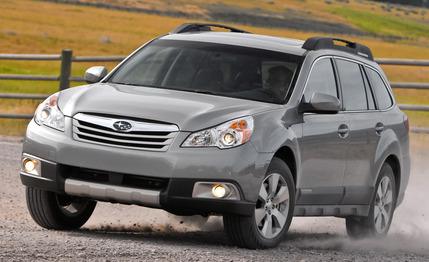 First Drive Review
First Drive Review
On its face, redesigning the Subaru Outback would seem like an easy task since the existing model was very good at what it did. The last-generation Outback was already comfortable, all-weather and off-road capable, and able to haul pretty much whatever you threw at it, whether that meant a kayak, ten days’ worth of camping gear, or a 150-pound Great Dane. If you dug deeper, though, there were a few things that needed work.
Like rear-seat room, for starters. The last car’s tiny doors and pinched legroom put a serious cramp on the comfort of any back-seat occupants; the area was for children and pets only. But the 2010 has a wheelbase increase of 2.8 inches, which allows for longer rear doors and an extra 3.9 inches of leg-stretching room. Although the new Outback is 0.8 inch shorter in overall length, a height gain of 4.1 inches contributes to an increase in interior space of several cubic feet. Most of that is in the rear seat. Cargo space with the rear seats in place is up only 0.8 cubic foot, but when you fold the 60/40 split rear seatbacks, nearly six cubes have been gained. The move from a multilink rear suspension to a control-arm setup allows for a more usefully shaped cargo hold. Front legroom decreased by just over an inch, but we didn’t notice it a bit. The new car’s extra 2.0 inches of width mean that front occupants no longer will spend trips bumping elbows.
No Turbo Engine for 2010
The 2010 Outback offers two engines, whereas last year there were three. Sadly, the turbo four has been dropped (it remains an option in the equally redesigned 2010 Legacy sedan). So the engine lineup is now completely naturally aspirated and looks like this: The 2.5i model uses a 2.5-liter flat-four good for 170 hp and 170 lb-ft of torque, and the Outback 3.6R has the 3.6-liter flat-six from the Tribeca that makes 256 hp and 247 lb-ft of torque. All-wheel drive is, of course, standard, and both engines are available in base, Premium, and Limited trim levels.
The four-cylinder engine essentially carries over from the previous model with identical power and torque ratings, although it’s been tweaked to deliver the horsepower and torque peaks 400 rpm lower. It mates to a six-speed manual transmission or an all-new, Subaru-developed CVT. (The CVT is a $1000 option on base and Premium 2.5i models; it’s standard on the 2.5i Limited.) The engine can get a bit noisy and coarse at the highest rpm, but it’s smooth and quiet the rest of the time, and the CVT does a nice job of avoiding the drone typical of that kind of gearbox. Although it seems a bit silly to have paddle-selectable “ratios” in a CVT, the option is useful when you need to keep the engine at peak power or need some driveline braking when descending a grade. The base engine has enough power for almost anyone; it’s not going to spin all four wheels or anything, but it gets the job done well enough. Our only gripe was a lack of upper-range passing grunt.
Stepping up to the silky 3.6-liter six will certainly fix that. We found plenty of thrust on tap all over the tach, and there was even something in reserve at near-triple-digit speeds. It takes the place of the 3.0-liter boxer-six from last year, and power is up 11 hp and 32 lb-ft. This engine is bolted exclusively to a five-speed automatic and, unlike the old flat-six, is rated for regular-grade gas. There are steering-wheel-mounted paddle shifters here, too.
Wait Until You Get It Off-Road
On-road, the Outback boasts a supple ride, a quiet cabin, and a more refined demeanor than before. The seats are comfortable, with great thigh support front and rear. This is a very good cruiser, and it swallowed mile after mile of highway with ease. But the steering weights up too quickly and artificially just off-center, sometimes making it difficult to determine the precise amount of input you want to make on corner entry. On asphalt, the car wants to take things easy, and that’s fine. Who’s going to be racing an Outback, anyway?